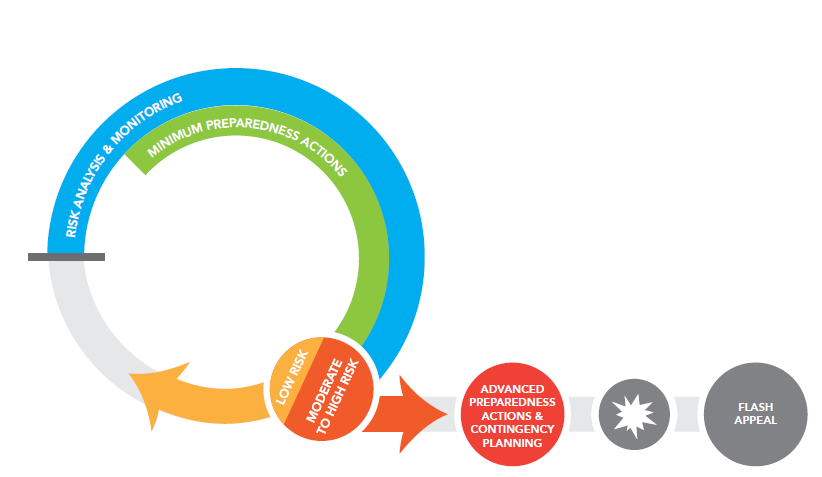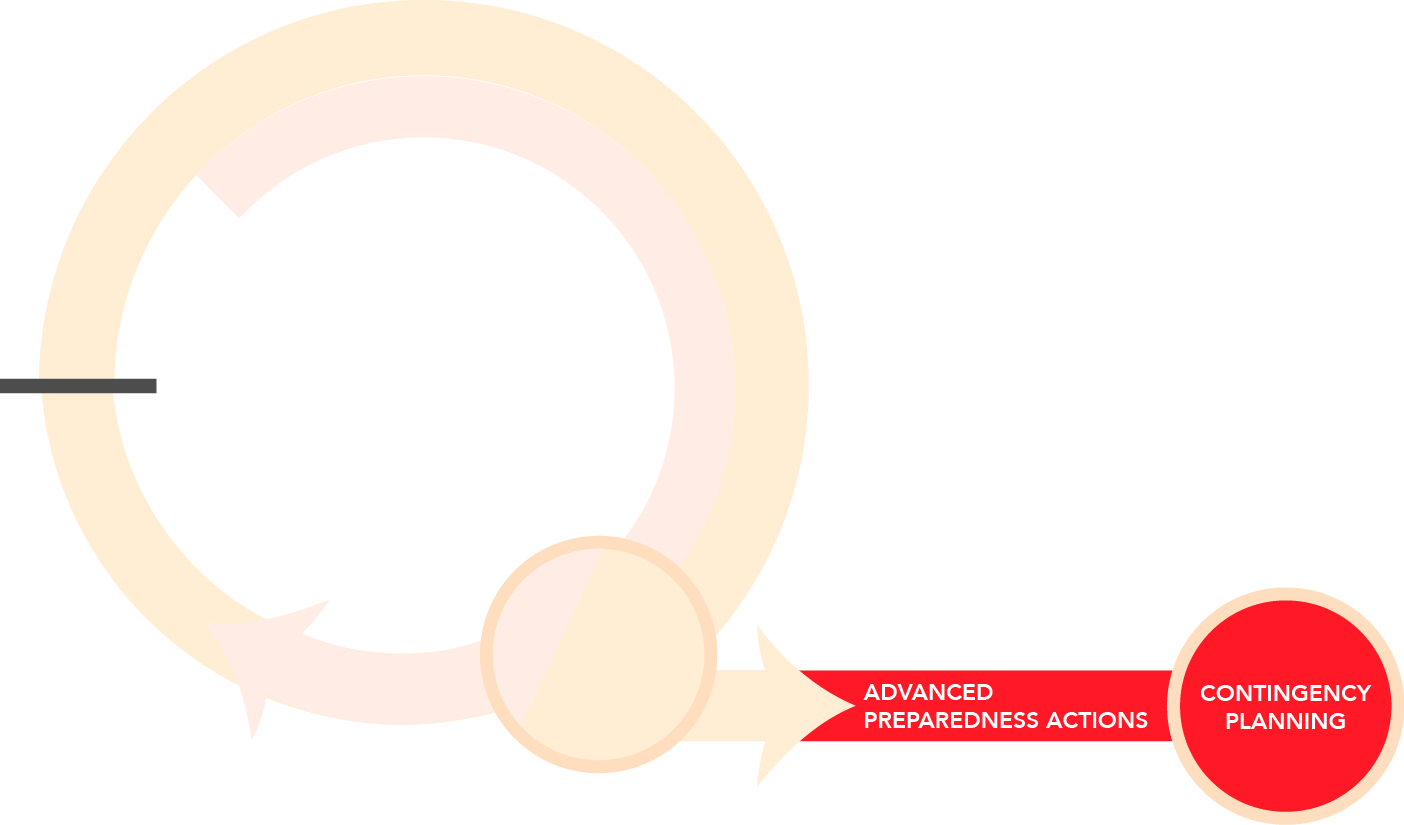Overview
Note. This guidance forms part of the Emergency Response Preparedness (ERP) approach. In its current form, it reflects the "BETA" version of the ERP, which the Inter-Agency Standing Committee (IASC) Task Team on Preparedness and Resilience released for field testing in 2015. The final version of the ERP may look different, once released.
ERP Advanced Preparedness Actions (APAs) are designed to guide a Humanitarian Country Team (HCT) to an advanced level of readiness to respond to a specific risk. Unlike MPAs, APAs are risk-specific. They build on MPAs already in place. The APA checklist includes essential preparedness actions which, though they are not specifically linked to the development of a contingency plan, complement and support the contingency planning process. ERP APAs are always implemented in conjunction with ERP contingency planning.
ERP APAs divide into the following categories.
a) Risk monitoring
The APA checklist outlines key actions that should be taken to ensure that risks are monitored regularly so that preparedness efforts are alert to emerging or developing risks.
b) Coordination and management arrangements
Clearly defined coordination and accountability mechanisms are critical to an effective humanitarian response. A clear understanding of roles and responsibilities enables individuals, teams and organizations to establish working relationships that can make all the difference during a crisis. It is also critical to establish appropriate linkages with Government counterparts and other key partners. APAs under this section identify key activities for ensuring a coherent coordination system in the event of an emergency.
c) Needs assessment, information management, and response monitoring arrangements
A coordinated needs assessment, that prioritizes the needs of women, men, girls and boys, and sub-groups of the population, lays the foundation for a coherent and efficient humanitarian response. It is also critical to establish a system for response monitoring. Response monitoring establishes systems and procedures that measure who receives aid (disaggregated by sex and age), what aid is delivered to them, and what results are achieved. It is underpinned by information management, which is the systematic process of collecting, processing, verifying, and analysing sex- and age- disaggregated data and information, and disseminating relevant information to humanitarian stakeholders, affected populations, and other interested parties. APAs under this section identify the key activities that need to be undertaken ahead of time to ensure these arrangements can be implemented in an emergency.
d) Operational capacity and arrangements to deliver relief and protection
The ability to respond in the immediate aftermath of an emergency depends on the level of operational readiness in place. Experience shows that in most emergencies there is an initial assistance gap because major response operations on average take at least three to four weeks to reach full capacity. Operational preparedness aims to reduce this gap to the extent possible and indicates the minimum level of readiness that should be in place to deliver humanitarian assistance and protection in a principled and accountable manner. This section is aimed primarily at sectors/clusters. The APA checklist includes actions: to identify the response capacity of sector/cluster partners, including national capacity (Government, local NGOs, and the private sector); the availability and location of critical relief items; and systems for procurement, transportation and distribution of critical relief items.
Key questions
1. Have all relevant actors in the specific cluster/ sector been identified, including the private sector, and is their capacity known and mapped?
2. Are all partners aware of the key principles for humanitarian response including:
- The centrality of protection.
- Accountability to affected populations, including effective two-way communication with affected communities.
- Humanitarian principles.
- Full mainstreaming of gender equality in humanitarian programmes.
3. Has due consideration been given to the suitable contents of a basic emergency relief package (taking cultural or gender equality implications or preferences into account), including the possible use of cash transfers and vouchers?
4. Have basic supply chain requirements been considered (the location of relief stocks, suppliers, logistics, etc.)?

Relevance for emergency operations
The IASC system adopts a forward looking ‘no regrets' approach to preparedness action, especially once thresholds identified through risk analysis have been met. This normally occurs when a risk is categorized as ‘medium' or higher (a risk ranking score of 8 or more). See ERP risk analysis and monitoring.
APAs have the following objectives:
- To increase the emergency preparedness level of the UN Country Team (UNCT) or Humanitarian Country Team (HCT), in view of the level of risk, to one of emergency readiness.
- To assist the UNCT or HCT and sector/clusters to identify elements that are essential for responding to a potential crisis. The same elements will in turn support preparation of an ERP contingency plan.
- To identify additional resource requirements, both human and financial.
- To feed into emergency preparedness planning by national authorities.

Main guidance
Underlying process – how does this work?
The triggering and implementation of ERP APAs and contingency planning should be led by the Resident Coordinator (RC) or Humanitarian Coordinator (HC), with participation by members of the UNCT or HCT. APAs should be reviewed regularly if the risk level remains medium or high for a longer period, or if the hazard that instigated the response worsens.
Step 1. APAs
1.1 Context and gap analysis
As a first step the UNCT or HCT should undertake a gap analysis to establish the current level of preparedness. An ERP includes key questions (see attached) to guide HCTs as they implement the APA checklist. These questions assist the UNCT/HCT or sector/cluster to identify and discuss gaps in preparedness. They are designed to gather essential background information and help to identify special requirements and operational constraints.
1.2 Prioritization
Based on the output of the gap analysis, the UNCT and/or HCT should prioritize the most pressing APAs, to be implemented first. All country teams have constraints on their capacity to implement preparedness. It is therefore essential to ensure that the prioritization process has the backing and buy-in of all those involved in implementing APAs.
1.3 Implementation
The UNCT and/or HCT should develop a work plan to implement the APAs, based on agreed prioritization. The APA checklist (see attachment) serves as a guide for this process.
1.4 Recording actions taken
It is very important to record accountabilities, deadlines and actions taken, so that the UNCT or HCT can clearly monitor the level of minimum preparedness that has been achieved. The APA templates (see attachment) can be used for this purpose.
Step 2. Developing a contingency plan
The UNCT or HCT should establish a work plan and timeline for developing a contingency plan. Accountability and deadlines for completing various section of the plan should be agreed and assigned. Given that the UNCT or HCT, under the leadership of the RC or HC, has overall responsibility for the contingency plan, regular consultation should take place and actions should be guided.
Step 3. Addressing preparedness gaps
Preparedness gaps that are identified during the planning process should be addressed. Again, this should be done in a systematic manner on the basis of accountabilities and deadlines that have been agreed and assigned.
Step 4. Testing the contingency plan
A schedule for regularly testing and reviewing the plan should be agreed. It should be linked to risk monitoring. Tools such as simulations should be used to test the plan.
UNHCR’s role and accountabilities
As a member of the UNCT and HCT, UNHCR fully participates in ERP. With respect to preparedness for IDP situations and natural disasters, UNHCR contributes to preparedness efforts led by the RC or HC.
The ERP is primarily applicable to inter-agency preparedness for natural disasters and internal displacement (IDP) situations. For potential refugee crises (where the identified emergency risk specifically relates to the possibility of a refugee emergency), UNHCR leads preparedness efforts with partners and the Preparedness Package for Refugee Emergencies (PPRE), which uses the same approach as the ERP, should be used as a toolkit and for guidance. The PPRE includes a specific inter-agency APA checklist for potential refugee crisis.
Links
Main contacts
Division for Emergency Security and Supply (DESS), Emergency Services. At: [email protected].
In this section:
Let us know what you think of the new site and help us improve your user experience….
Let us know what you think of the new site and help us improve your user experience….
